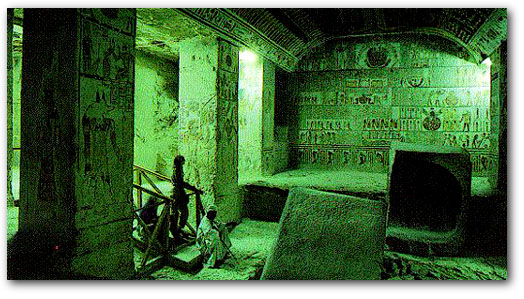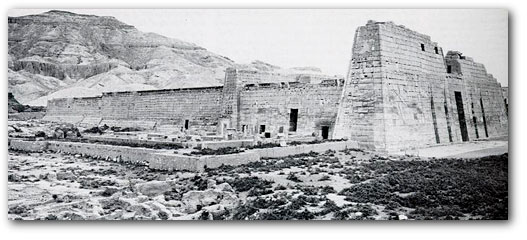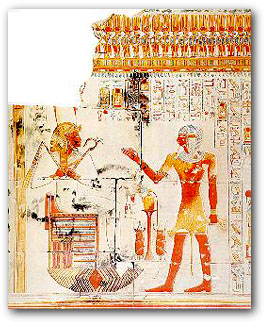| Valley of the
Kings Tombs of the
Pharaohs

The Egyptian belief that "To speak the name of
the dead is to make him live again" is certainly
carried out in the building of the tombs. The king's
formal names and titles are inscribed in his tomb along
with his images and statues. Beginning with the 18th
Dynasty and ending with the 20th, the kings abandoned the
Memphis area and built their tombs in Thebes. Also
abandoned were the pyramid style tombs. Most of the tombs
were cut into the limestone following a similar pattern:
three corridors, an antechamber and a sunken sarcophagus
chamber. These catacombs were harder to rob and were more
easily concealed. Construction usually lasted six years,
beginning with the new reign. The text in the tombs are
from the Book of the Dead, the
Book of the Gates and the Book of the Underworld.
Ramesses IV
Three white corridors descend to the sarcophagus
chamber. The chambers ceilings depict the goddess Nut.
The lid of the pink granite sarcophagus is decorated with
Isis and Nephthys, which were meant to serve as guardians
over the body. Their duties fell short, however, as the
tomb was robbed in ancient times. Originally the priests
placed the sarcophagus in Amenhotep II II's tomb in order
to hide the body, which was a common practice.
Ramesses IX
Two sets of steps lead down to the tomb door that
is decorated with the Pharaoh worshipping the solar disc.
Isis and Nephthys stand behind him on either side. Three
corridors lead into an antechamber that opens into a
pillared hall. The passage beyond that leads to the
sarcophagus chamber.
Merneptah
The steep descent into the tomb is typical of the
designs of the XIX Dynasty. The entrance is decorated
with Isis and Nephthys worshipping the solar disc. Text
from the Book of the Gates line the corridors. The outer
granite lid of the sarcophagus is located in the
antechamber, while the lid of the inner sarcophagus is
located down more steps in the pillared hall. Carved on
the pink granite lid is the figure of Merneptah as
Osiris.
Ramesses VI
Originally built for Ramesses V, three chambers
and a 4th pillared chamber was added by Ramesses VI.
Complete texts of the Book of the Gates, the Book of
Caverns and the Book of Day and Night line the chambers.
Portions of the Book of the Dead
are located in the pillared chamber, along with scenes of
the skygoddess, Nut.

The Burial Chamber in the
Tomb of Ramesses VI
Ramesses III
The tomb is sometimes referred to as the
"Harpers Tomb" due to the two harpers playing
to the gods in four of the chambers. Ten small chambers
branch off of the main corridors. These were for the
placement of tomb furniture.

Mortuary Temple of
Ramesses III at Medinet Habu
Seti I
The longest tomb in the valley, 100m, contains
very well preserved reliefs in all of its eleven chambers
and side rooms. One of the back chambers is decorated
with the Ritual of the Opening of the Mouth, which stated
that the mummy's eating and drinking organs were properly
functioning. Believing in the need for these functions in
the afterlife, this was a very important ritual. The
sarcophagus is now in the Sir John Soane Museum, London.

From the Temple of Seti I
at Abydos
Tuthmosis III
The approach to this unusual tomb is an ascent up
wooden steps, crossing over a pit, and then a steep
descent down into the tomb. The pit was probably dug as a
deterrent to tomb robbers. Two small chambers, decorated
with stars, and a larger vestibule are in front of the
sarcophagus chamber, which is uniquely rounded and
decorated with only red and black.
Amenhotep II
A steep flight of stairs and a long unadorned
corridor lead to the sarcophagus chamber. Three mummies,
Tuthmosis IV, Amenhotep II III and Seti II, were found in
one side room and nine mummies were found in another.
Horemheb
This tomb's construction is identical to that of
Seti I's with the exception of some of the inner
decorations.

Temple
Tutankhamun
Though small and unimpressive, Tutankhamun's Tomb
is probably the most famous, due to its late discovery.
Howard Carter's description upon opening the tomb in 1922
was, "At first I could see nothing, the hot air
escaping from the chamber causing the candle flames to
flicker, but presently, as my eyes grew accustomed to the
light, details of the room within emerged slowly from the
mist, strange animals, statues and gold - everywhere the
glint of gold. For the moment - an eternity it must have
seemed to the others standing by - I was dumb with
amazement, and when Lord Carnarvon, unable to stand the
suspense any longer, inquired anxiously, 'Can you see
anything?' it was all I could do to get out the words,
"Yes, wonderful things."' The royal seal on the
door was found intact. The first three chambers were
unadorned, with evidence of early entrance through one of
the outside walls. The next chamber contained most of the
funerary objects. The sarcophagus was four guilded wooden
shrines, one inside the other, within which lay the stone
sarcophagus, three mummiform coffins, the inner one being
solid gold, and then the mummy. Haste can be seen in the
reliefs and the sarcophagus, due to the fact that
Tutankhamun died at only 19 years of age following a
brief reign. Though extremely impressive to the modern
world, the treasures of Tutankhamun must have paled when
compared to the tombs of the great Pharaohs that ruled
for many years during Egypt's golden age.

From the Tomb of
Tutankhamun
|





